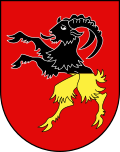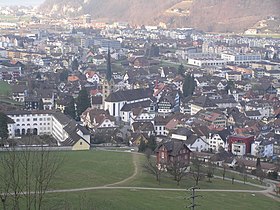Stans
| Stans | |
|---|---|
| State : |
|
| Canton : |
|
| District : | No district division |
| BFS no. : | 1509 |
| Postal code : | 6370 |
| UN / LOCODE : | CH SAN |
| Coordinates : | 670 604 / 201070 |
| Height : | 452 m above sea level M. |
| Height range : | 435–1817 m above sea level M. |
| Area : | 11.08 km² |
| Residents: | 8393 (December 31, 2018) |
| Population density : | 757 inhabitants per km² |
|
Proportion of foreigners : (residents without citizenship ) |
12.0% (December 31, 2,015) |
| Mayor : | Gregor Schwander ( CVP ) |
| Website: | www.stans.ch |
|
Look at Stans |
|
| Location of the municipality | |
Stans is a political municipality and the capital of the canton of Nidwalden in Switzerland .
geography
The village of Stans lies between the Stanserhorn and Buochserhorn mountains and the western foothills of the Bürgenstock . Neighboring communities are Ennetmoos and Stansstad in the west, Oberdorf , Ennetbürgen and Buochs in the east and Dallenwil in the south, with Stansstad, Ennetbürgen and Buochs on Lake Lucerne .
43.7% of the entire municipal area is used for agriculture. Another 36.5% is covered by forest and wood. In addition to 2.6% unproductive area, 17.2% is settlement area.
history

The Gallo-Roman cremation graves from the 2nd century BC. Are the earliest traces of human presence in Nidwalden. The name Stans, which is derived from the Latin word stagnum (pond, standing water) is another indication of this. The community was first mentioned in 1172. In 1798, Stans was attacked by French troops, as Nidwalden rebelled against the new constitution by Napoléon Bonaparte . After these terrible days in Nidwalden , the teacher Johann Heinrich Pestalozzi took the orphaned children into his first school. The Nidwaldner Landsgemeinde was held in Oberdorf until it was abolished in 1997.
Attractions
- The main attractions of Stans are the Stanserhorn at 1898 m above sea level. M. , which is accessible by the Stanserhorn railway , the village square, the church of St. Peter and Paul , built between 1641 and 1647 , the St. Klara monastery , the Winkelried monument by Ferdinand Schlöth and the Winkelriedhaus .
- In the former Capuchin Church, devotional images of the Swiss saint Niklaus von Flüe and the Lebanese saint Scharbel Machluf are set up, both of which have a very similar vita and whose importance for the spiritual and religious tradition of their home countries also shows similarities.
- The Höfli , also known as Rosenburg , is a secular building whose origins go back to the 14th century.
photos
Winkelried memorial from 1865
Winkelriedhaus from the 15th century
College of St. Fidelis (1883)
Stanserhorn in the fog
population
Population development
The population grew rapidly in the 1850s. In the following decade, growth flattened a little, but then picked up again sharply from the 1870s. Overall, the population grew by 921 people, or 49.1%, between 1850 and 1900. The number of residents stagnated between 1910 and 1930. From 1930 until today there has been constant growth. Today the community has well over 8,000 inhabitants. In 2008 alone it grew by 210 people or 2.8%. Together with the surrounding communities, it forms the agglomeration of Stans (Beckenried, Buochs, Ennetbürgen, Ennetmoos, Oberdorf, Stans and Stansstad) with (end of 2017) 31,946 inhabitants. Of the 8,411 inhabitants at the end of 2017, 4,209 were male and 4,202 were female.

Population development of Stans since 1850 Source: Population censuses (1850–2000 Federal), Federal Statistical Office (2010 and 2015)
languages
The population speaks a highly Alemannic dialect. Almost the entire population speaks German as the everyday language. In the last census in 2000, 91.6% said German, 2% Italian and 1.2% Serbo-Croatian as their main language.
Religions - denominations
The population used to be fully members of the Roman Catholic Church. The denominational relationships in 2000 still show the original structure. 5354 people were Catholic (76.67%). In addition, there were 10.83% Evangelical Reformed and 1.02% Orthodox Christians, 2.96% Muslims and 5.13% non-religious. 190 people (2.72%) did not provide any information about their creed.
Origin - nationality
7,198 (86.96%) of the residents were Swiss nationals at the end of 2015. The majority of the immigrants come from Central Europe (Germany), Southern Europe (Italy and Portugal), the former Yugoslavia (Serbia / Montenegro, Kosovo and Bosnia-Herzegovina) and Sri Lanka. At the 2000 census, 6,256 people (89.59%) were Swiss citizens; 297 of them had dual citizenship.
age structure
The church has a high percentage of younger people. While the proportion of people under the age of twenty makes up almost 23.89% of the local population, only just under 18.24% are senior citizens (60 years and older). The largest age group is made up of people between 30 and 44 years of age. The average age is around 37 years.
The last census in 2000 showed the following age structure:
| Age | 0–6 years | 7-15 years | 16-19 years | 20-29 years | 30–44 years | 45–59 years | 60–79 years | 80 years and more |
| number | 561 | 798 | 309 | 816 | 1795 | 1430 | 957 | 317 |
| proportion of | 8.03% | 11.43% | 4.43% | 11.69% | 25.71% | 20.48% | 13.70% | 4.54% |
economy
In 2017, of the 9,939 employees, 5,470 were male and 4,469 were female. Among other things, the largest Swiss aircraft manufacturer Pilatus Aircraft is based in Stans. Less than 30% of the jobs are filled by locals. Only a few employees in Stans still work in agriculture / forestry / fishing (sector 1). Around a third of the labor force is employed in industry and commerce (sector 2). The majority of employees work in service companies (sector 3).
The numbers for the 3 sectors are as follows:
| Companies 1st sector |
Employees 1st sector |
Full-time positions 1st sector |
Companies 2nd sector |
Employees 2nd sector |
Full-time positions 2nd sector |
Companies 3rd sector |
Employees 3rd sector |
Full-time positions 3rd sector |
Operations total |
employees Total |
Total full-time positions |
|
| number | 30th | 90 | 66 | 127 | 3333 | 3095 | 877 | 6516 | 4705 | 1034 | 9939 | 7866 |
| proportion of | 2.90% | 0.91% | 0.84% | 12.28% | 33.53% | 31.14% | 84.82% | 65.56% | 59.81% | 100% | 100% | 100% |
| Source: Federal Statistical Office; Statistics of the company structure STATENT, workplaces and employees by municipality and economic sector | ||||||||||||
In 2000, of the 7,075 employed, 2,088 people were from Stans and 4,987 were commuters. Most of them (67%) came from the canton of Nidwalden - but there were also around 700 people from the canton of Lucerne and 500 from the canton of Obwalden. At the same time, 1,744 people from Stans went to work in other parishes; including 45% in the canton of Lucerne and only 32% in other Nidwalden communities.
traffic
Stans is located directly on the A2 Basel - Lucerne - Gotthard motorway . In order to relieve the community of alternative traffic on the motorway in the future, a traffic control concept was developed.
In 1893 the Stanserhorn-Bahn (SthB) opened, a funicular that leads to the Stanserhorn. About which opened in the same year Electrical streetcar Stansstad Stans was (StSt) connection with the steamers of Lake Lucerne in Stansstad. Due to competition from the Stansstad-Engelberg-Bahn (StEB), which opened in 1898 and runs from Stansstad via Stans to Engelberg , the tram was shut down in 1903. Due to financial difficulties, the StEB was initially shut down in 1964. As a result, the line was completely renovated and an extension was built up to the Brünigbahn in Hergiswil . The line was then reopened as the Luzern-Stans-Engelberg-Bahn (LSE) with a connection to Lucerne. At the beginning of 2005 the LSE merged with the Brünigbahn to form the Zentralbahn (ZB).
Personalities
- Ludwig Maria Keyser (1765–1840), politician
- Melchior Paul von Deschwanden (1811–1881), artist of the Nazarene style
- Franz Anton Rohrer (1832–1882), church historian, priest and librarian at the St. Gallen monastery
- Robert Durrer (1836–1889), lawyer and politician
- Hans von Matt (1842–1900), publisher and antiquarian
- Athanasius Staub (1864–1955), theologian
- Robert Durrer (1867–1934), historian, judge and archivist
- Gabriel Zelger (1867–1934), missionary in Tanzania
- Eduard Zimmermann (1872–1949), sculptor
- Grete Hess (1894–1976), artist, writer and radio presenter
- Marie Odermatt-Lussy (1891–1971), folklorist
- Leutfrid Signer (1897–1963), Rector of the St. Fidelis College
- Arnold Odermatt (* 1925), police officer and photographer
- Hans Küchler (1929–2001), graphic artist, watercolorist, glass painter, illustrator and object artist
- Peter von Matt (* 1937), literary scholar and journalist
- Beat Wyrsch (* 1946), director and former theater director
- Pi Ledergerber (* 1951), sculptor
- Jo Achermann (* 1954), sculptor
- Urs Odermatt (* 1955), director
- Silvia Götschi (* 1958), writer
- Bruno Amstad (born 1964), singer
- Lucia Mayer-Hofmann (* 1979), long-distance runner
- Markus Vogel (* 1984), ski racer
- Zoël Amberg (* 1992), racing driver
Web links
- Stans parish
- Emil Weber: Stans. In: Historical Lexicon of Switzerland .
Individual evidence
- ↑ Permanent and non-permanent resident population by year, canton, district, municipality, population type and gender (permanent resident population). In: bfs. admin.ch . Federal Statistical Office (FSO), August 31, 2019, accessed on December 22, 2019 .
- ↑ https://secure.i-web.ch/dweb/nw/de/onlinemain/publikationen/?pubid=8254&action=info ( page no longer available , search in web archives ) Info: The link was automatically marked as defective. Please check the link according to the instructions and then remove this notice.
- ^ Stans online: History , accessed on July 28, 2010.
- ↑ Nidwalden is fighting against traffic jams with dead ends and bans. In: luzernerzeitung.ch . January 30, 2020, accessed January 30, 2020 .












